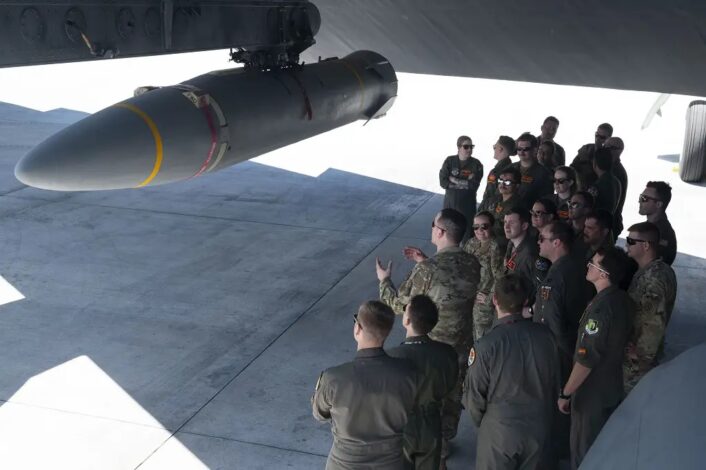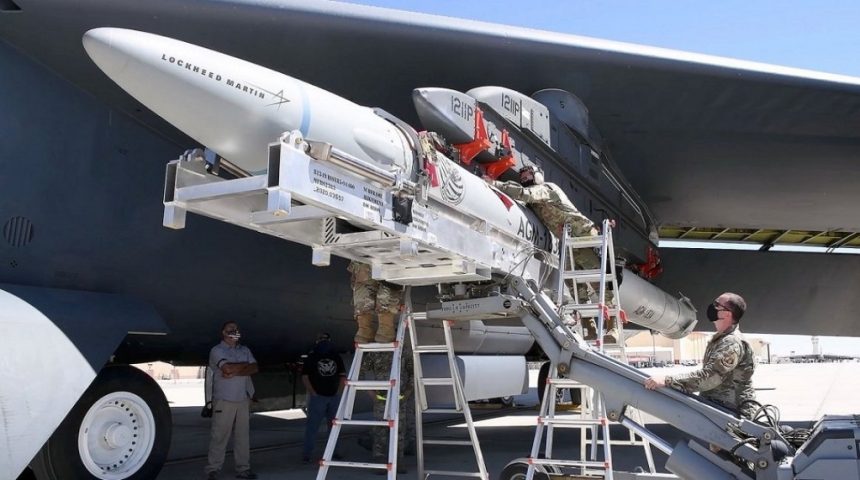The test was performed on March 17, few weeks after the missile was photographed at Andersen Air Force Base under a B-52’s wing.
The U.S. Air Force confirmed that a B-52H Stratofortress, departed from Andersen Air Force Base, Guam, launched a live AGM-183 Air-Launched Rapid Response Weapon on March 17, 2024, in what could be the last test of the hypersonic weapon. The test, the first of a US hypersonic weapon in the Indo-Pacific area, was kind of expected, as rumors started circulating after the missile’s presence on Guam was acknowledged by the Air Force and the appearance of a NOTAM for weapon testing.
“A B-52H Stratofortress conducted a test of the All-Up-Round AGM-183A Air-launched Rapid Response Weapon,” said an Air Force spokesperson. “This test launched a full prototype operational hypersonic missile and focused on the ARRW’s end-to-end performance The test took place at the Reagan Test Site with the B-52 taking off from Andersen Air Force Base, Guam on March 17, 2024 local time.”
The service did not say if the test was successful, however it mentioned that the test provided “valuable insights into the capabilities of this new, cutting-edge technology”. No mention was made also regarding whether the missile struck the surface or a target, although the recent DOT&E report stated that end-to-end test up until the impact was planned. The Reagan Test Site, near Kwajalein Atoll, was used in the past for impact testing of other weapons.
“This test acquired valuable, unique data and was intended to further a range of hypersonic programs,” the spokesperson added. “We also validated and improved our test and evaluation capabilities for continued development of advanced hypersonic systems.” An important part in the data gathering during the test was played by naval surface test monitoring vessels and Missile Defense Agency monitoring aircraft that were noticed deploying and operating in the area at the time of the test.
Lockheed Martin, the manufacturer of the AGM-183, mentioned that this was indeed the last test of the ARRW program and added it is ready to deliver ARRW technology or other hypersonic capabilities to the Air Force. The company is, in fact, working also on the other hypersonic program of the Air Force, the Hypersonic Airbreathing Weapon Concept.
“Following the recent end-to-end flight test, Lockheed Martin has completed the test program with full confidence in ARRW’s revolutionary capabilities, and we stand ready to deliver this fully-qualified, hypersonic solution to the U.S. Air Force,” the company said. “Building on ARRW’s industry-leading technology and testing success, Lockheed Martin can quickly deliver additional hypersonic-strike assets that can be rapidly deployed to the U.S. military.”

The missile’s arrival on Guam
The U.S. Air Force published on February 29 photos showing a live (yellow-band) AGM-183 Air-launched Rapid Response Weapon under the wing of a B-52H which deployed to Andersen Air Force Base for a Bomber Task Force. The photos, according to the press statement, were shot on Feb. 27, as B-52 crews from the 23rd Expeditionary Bomb Squadron and 49th Test and Evaluation Squadron participated in hypersonic weapon familiarization training.
The participating crews received expert academics and training on hypersonic fundamentals and participated in tactical discussion on hypersonic operations to increase operational readiness and prepare multiple Air Force aircraft communities for hypersonics including the Hypersonic Attack Cruise Missile, Air-launched Rapid Response Weapon, and other programs under development. The crews focused on the fundamentals of hypersonics, operational and logistics considerations, and in-depth tactical discussions.
The photos are particularly significative as Guam is located in a strategic position in the Indo-Pacific region and, to our knowledge, this is the first time a US hypersonic weapon is seen this close to China. The March 17 test is now even more significative and, since it was supposed to replicate an operational mission where the bomber flies for 4,000 km before launching the hypersonic weapon, many saw this as a signal to China. In fact, US hypersonic technology is often considered behind China’s, however the Department of Defense is working to rapidly field operational hypersonic systems, with many programs being pursued by Air Force, Navy and Army, although they suffered numerous setbacks.
The AGM-183 ARRW
The AGM-183A ARRW is based on hypersonic glide vehicle technology derived from the Air Force and Defense Advanced Research Projects Agency (DARPA) Science and Technology (S&T) Demonstration known as Tactical Boost Glide (TBG). A fragmenting glide vehicle is launched from a conventional rocket, or more precisely a Solid-Rocket Motor (SRM) booster, to the upper atmosphere and, once it reaches hypersonic speeds, it separates from the rocket and glides to its target at speeds up to Mach 15. At these speeds, there is no need for a conventional explosive warhead as the kinetic energy alone delivered during impact would be enough to destroy most targets.
The Air Force also defined the ARRW as an “operational hypersonic air-launched weapon enabling the U.S. to hold fixed, high value, time-sensitive targets at risk in contested environments from standoff distances.” The missile would have provided a survivable, lethal, long-range strike capability to go after high-end capabilities of a potential adversary, such as deep-inland strike against targets of strategic importance and coastal strike against high-end systems. Initially, the expected introduction in service of the AGM-183 was planned for 2022.

Last year, the Air Force said it does not currently intend to pursue follow-on procurement of ARRW once the prototyping program concludes, adding that there is inherent benefit to completing the all-up round test flights to garner the learning and test data that will help inform future hypersonic programs. The decision apparently was influenced by the latest test flight of the missile at that time, which ended with another failure. The FY 2025 Budget Request also does not include ARRW.
Although the Air Force decided in April 2023 to not pursue the procurement of the weapon, the Director, Operational Test & Evaluation report recently mentioned that the ARRW program has shown preliminary indications that it could become an operationally lethal weapon, however the lack of terminal characterization data to date, due to technical failure of the test range sensor systems in the December 2022 test and the shroud not ejecting in March 2023, does not yet allow for a full assessment. Preliminary info released from the August 2023 test’s data analysis say it achieved nominal conditions.
The report continues saying that, given the limited number of planned test events, there is a risk that the test program will not be able to demonstrate the ARRW lethal effects against the required tactical and strategic targets. The survivability assessment estimated the probability that a single ARRW will complete its mission, given the capabilities of various early warning radars, surface-to-air missile systems, and anti-aircraft artillery batteries to detect and engage ARRW in various one-on-one scenarios, indicating that it will meet its survivability requirements.









